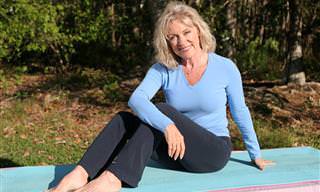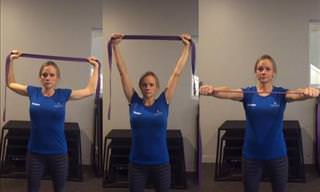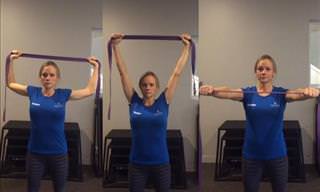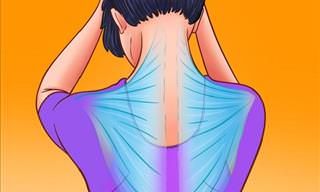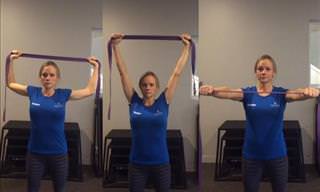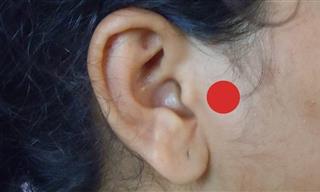|
If you want to stay supple and retain the elasticity of your upper body muscles as you get older, then some simple stretching exercises can be greatly beneficial. Upper body stretches can help you maintain and even improve the range of motion across your torso, shoulders, arms and hands so that you can continue to fulfill your daily tasks and maintain your quality of life.
Many of the stretches described in this article and demonstrated by helpful videos are really simple to complete and suitable for pretty much everybody. Just pick the ones that would most benefit you and add them to your weekly fitness routine!
|
 |
|
What are the benefits of upper body exercises?
Upper body strengthening exercises can be extremely useful for overall health and well-being as you age. There are a range of exercises that work different muscles to help protect your ability to perform key tasks and allow you to:
- Strengthen the muscles responsible for reaching.
- Maintain your ability to complete lifting and pushing motions without associated pain or weakness.
- Lift your arms above your head, supporting everyday tasks like undressing and hair grooming.
- Ward off daily aches and pains in the shoulders, neck and arms.
- Maintain a full range of hand motion for tactile tasks involving buttons, zippers and laces.
- Support overall strengthening throughout your trunk to help you retain movement in your back and neck.
- Avoid and treat the onset of arthritis.
You don't need to run through a vigorous daily fitness routine to preserve your upper body strength. Just add a few of these short and easy exercises to your weekly routine and build from there.
|
| |
|
1. Shoulder Rolls
|
|
Benefits:
- Supports your ability to retain motion in your shoulders.
- Helps maintain the muscles responsible for actions like reaching for a high shelf, removing upper body clothing or stretching across a table at dinner.
- Associated strengthening of the upper back region and rib muscles.
Instructions:
- Take up a comfortable position in a supportive chair (not soft upholstery).
- Carefully raise your shoulders up, back, then down in a circular motion. Inhale as you raise them, exhale as you return them downwards.
- Exercise both shoulders at the same time and repeat 10 times before relaxing.
|
|
|
|
Tips:
- If you feel any discomfort, adjust the speed of the exercise accordingly.
- Breathe deeply as your raise your shoulders. Filling your lungs with air will naturally encourage the 'raising' motion.
- Make sure you release the air as you move downwards. Do not hold your breath.
- If you are feeling confident, hold a 1 pound weight (or equivalent from the kitchen - carton of juice or similar) in each hand and let you arms hang by your side as you complete the exercise.
|
| |
|
2. Overhead Reach
|
|
Benefits:
- Designed to help you maintain your ability to reach - both above your head and out in front of your body.
- Helps with a number of daily tasks, including picking objects up from the floor, reaching up to high shelves and clearing the table.
- Increases your range of motion in both your shoulders and your back.
Instructions:
- Take a position in a supportive chair with your back straight and your feet flat on the floor.
- Hold one hand in the other and place both hands on your lap. Inhale deeply before beginning the exercise.
- Gently raise your interlocked hands above your head while exhaling.
- Hold your arms at the highest point of the stretch for a couple of seconds.
- Slowly return your arms to the starting position and repeat the process 10 times.
|
|
|
|
Tips:
- Keep your spine straight throughout the exercise and allow your ribs to raise as you move upwards.
- Inhale through the nose and breathe out through the mouth.
- Lift your arms gently and only to a point where they feel comfortable.
- If you are feeling confident, gently lean to the right side when your arms reach the highest point. Repeat the process on the left side.
|
| |
|
3. Reach Back
|
|
Benefits:
- A safe and simple way to exercise the shoulders without hyper-extension or over-stretching.
- Retains the suppleness of the muscles responsible for reaching back, for example when you need to hold on to an arm rest or wall when sitting down.
- Improves the range of motion in the shoulders and encourages associated strengthening of the chest.
Instructions:
- Stand with your legs just slightly apart in front of a supportive chair.
- Gently hold one hand in the other behind your back. Take a deep breath.
- Gently move your arms out behind you while exhaling.
- Return your arms to their starting position while inhaling.
|
|
|
|
Tips:
- Keep your spine as straight as possible both before and during the exercise.
- Breathe in through your nose and exhale through your mouth.
- You should feel comfortable as you perform the stretch. If you find yourself in pain, do not complete the full set of repetitions. Always put your comfort first.
- If you are feeling confident, gently lean forward at your waist as you bring your arms back, while keeping your back straight.
|
| |
|
4. Hand Stretch
|
|
Benefits:
- Helps loosen up the fingers and palms, which are often among the most likely parts of the body to stiffen up over night.
- Helps keep the hands tactile, supporting a range of 'fiddly' tasks we have to complete daily.
- Promotes the ability to grip and open/close your hands quickly.
- Increases the overall range of movement in the hands and fingers.
Instructions:
- Either sit or stand, but hold both hands out in front of you with your palms facing downwards.
- Open and close your hands. Spread your fingers apart as you perform the 'opening' phase. Breathe normally throughout the exercise.
- Repeat 10 times.
|
|
|
|
Tips:
- Do not force the exercise or strain to complete. Open and close the hands at a normal speed and force.
- If you struggle to hold your shoulders up to complete the exercise, drop your hands to your lap for support.
- Try and spread your fingers as wide as possible as you open your hand.
- If you are feeling confident, add wrist circles during the exercise to work the muscles more vigorously.
|
|
|
|
5. Neck Rotations and Side Bends
|
|
Benefits:
- Helps warm joint fluids and develop deep muscle fibers that can deteriorate as we get older.
- Strengthens the muscles and joints responsible for allowing us to look over our shoulder, really important when driving, shopping, or out in a crowded place.
- Improves the overall range of movement in the neck and has associated benefits for the upper back and shoulder blades.
Instructions:
- Sit in a comfortable and supportive chair, facing forwards with your back straight and your feet out in front of you.
- Gently turn your neck to the right as far as it will comfortably go and hold the position for five seconds. Breathe normally throughout the exercise.
- Return to your starting position and then repeat the exercise but look left this time.
- Return to the starting position and then gently tilt your right ear towards your right shoulder while breathing normally. Stop when you feel resistance and hold the pose for 5 seconds.
- Return to the starting position and repeat the process with the left ear moving towards the left shoulder.
|
|
|
|
Tips:
- Move slowly and precisely, make sure you don't stretch further than comfortable.
- Hold your shoulder still and keep your back straight-yet-relaxed while turning your head.
- When performing the side bends, ensure you bring the ear to the shoulder, rather than the shoulder to the ear.
- If you are feeling confident, hold on to the sides of the chair's seat as you perform the exercise. This will increase the range of the stretch.
|
| |
|
6. Chest Stretch
|
|
Benefits:
- Helps promote rib and upper chest mobility, improving breathing as it does so.
- Improves the overall strength of the upper body, with associated benefits for the shoulders.
- Improves posture and promotes the maintenance of lung function.
Instructions:
- Take a seat in a comfortable but supportive chair.
- Raise your arms behind you, placing your hands together on the back of your head.
- Slowly move your neck and shoulders backwards while breathing in to fill your lungs.
- Hold the position briefly and then breathe out. Relax your body before repeating three more times.
|
|
|
|
Tips:
- Lift your ribs with the natural motion of the neck and shoulders as you move them backwards.
- Breathe deeply all the way to the bottom of the abdomen.
- Tuck your chin in and keep your neck straight as you perform the exercise.
- If you are feeling confident, while your hands are behind your head, lean to the right while breathing out. Repeat on the left hand side during the next repetition of the exercise.
|
| |
|
7. Shoulder & Upper Back Stretch
|
|
Benefits:
- A great stretch to protect and promote the range of movement in the shoulders and shoulder blades.
- Helps maintain your ability to reach and stretch, especially to high areas of your kitchen or other rooms of the home.
- Associated benefits for the upper back and chest.
Instructions:
- Take a seat in a comfortable but supportive chair.
- Bring your palms together in front of you in a 'prayer' position. Take a deep breath in through your nose.
- Keeping your hands together, exhale as you lift your arms upwards.
- Reach a comfortable high point and then slowly move your arms apart.
- Lower your arms back into the starting position while inhaling.
- Repeat 5 times.
|
|
|
|
Tips:
- Try to avoid jerking motions - make sure the exercise is smooth.
- As you lower your arms, squeeze your shoulder blades together while breathing in.
- Try to keep your chest straight and raised throughout.
- If you are feeling confident, add a one pound weight to each wrist as you perform the exercise.
|
| |
|
8. Shoulder Circles
|
|
Benefits:
- A dynamic stretch that helps improve the range of motion in the shoulders and upper back.
- Associated benefits for the chest and lungs.
- Promotes increased power, crucial for lifting heavier objects.
Instructions:
- Take a seat in a comfortable but supportive chair.
- Bend your elbows to allow you to place your fingertips on your shoulders.
- Move your shoulders forwards in a circular motion. Repeat the exercise 15 times.
- Once you have finished the repetitions, repeat the exercises again but this time move your shoulders in a backwards motion.
- Breathe at your normal rate throughout, in through your nose and out through your mouth.
|
|
|
|
Tips:
- Keep your body straight so that your ribs are raised throughout.
- Try to stop your elbows from slouching while you complete the circles. Keep them nice and raised.
- A good trick you can use to make sure you run through the exercise fully is to pretend that you have a pencil on the end of each elbow and you are drawing an imaginary circle on the wall ahead of your eye line.
- If you are feeling confident, try running through the exercise while standing up.
|
| |
|
9. Triceps Stretch
|
|
Benefits:
- Improves flexibility of muscles and tendons used for a number of functional activities.
- Loosens motion so that a full range of movement can be retained in the arms and shoulders.
- Improves your ability to reach across the body, twist and turn.
Instructions:
- Take a seat in a comfortable but supportive chair.
- Raise your left hand up and across on to your right shoulder.
- Use your right hand to provide some support for the elbow and very gently pull it towards your right shoulder.
- When you feel resistance, pause and hold the stretch for 10 to 15 seconds.
- Repeat for the other shoulder and complete 10 repetitions for each.
- Breathe normally throughout - in through the nose and out through the mouth.
|
|
|
|
Tips:
- Try to keep your elbow up at shoulder height.
- Keep your ribs raised as you complete the exercise.
- You should be able to feel the benefit of the stretch without genuine pain. If you do sense pain, stop.
- If you are feeling confident, keep your elbow straighter as you pull it back towards the shoulder.
|
| |
|
10. Arm Raises
|
|
Benefits:
- Maintains elasticity and flexibility throughout the upper body.
- Strengthens the muscles responsible for lifting, reaching overhead and driving a vehicle.
- Encourages increased range of movement in the shoulders, chest and upper back.
Instructions:
- Stand with your arms hanging loosely at your sides and your palms facing towards your body.
- Relax your shoulders and keep your ribs raised as you inhale while lifting both your arms upwards and above your head.
- Inhale as you return your arms to their starting position.
- Complete 10 repetitions, or an amount that feels comfortable.
|
|
|
|
Tips:
- Keep your back straight throughout the exercise, try not to arch it.
- Do not clench your fists, keep your fingers loose and open.
- Try completing the exercise against a wall to ensure your posture and alignment are correct.
- Try to stretch a little further with every repetition, but do not overdo it and cause yourself pain.
- If you are feeling confident, bring your arms out to your sides on every other repetition.
|
| |
| |
 Go to BabaMail
Go to BabaMail



